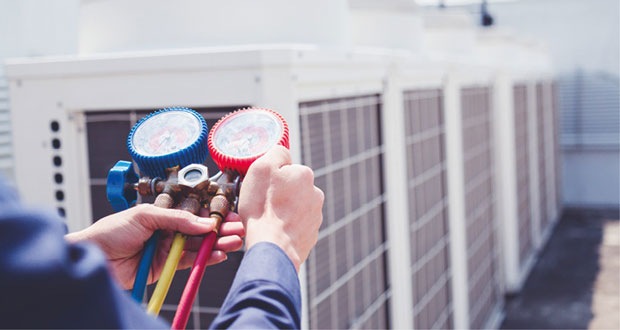 Stewart McGillivray, from Guardian Water Treatment, looks at the changing face of UK commercial buildings and what needs to be considered to keep HVAC safe, efficient and operational
Stewart McGillivray, from Guardian Water Treatment, looks at the changing face of UK commercial buildings and what needs to be considered to keep HVAC safe, efficient and operational
Post-pandemic, the face of the working world has changed forever. Total home working had declined steadily over the past few years, but our desire for a more flexible approach to where we work has endured. Recent data from Leesman shows that 74 per cent of UK employees plan to be in the office two or fewer days a week, with Monday and Friday being particularly quiet.
To attract people out of the spare bedroom, commercial buildings need to do more than simply provide a place to ‘work’. Breakout zones and areas to eat, play and socialise are becoming very much part of the modern office. Canary Wharf, for example, is set to receive a major upgrade, partnering with the Eden Project to enhance green spaces and eco credentials. Inside, existing commercial buildings are adding more collaborative areas, which is sometimes leading to more square footage despite workers being in the office less.
Mark Kowal, Senior Vice President of the British Council for Offices and Partner at Sheppard Robson said: “It is myth that more flexible or hybrid working heralds a decline in the desire for office space…Over the past five years, the adoption of activity-based working and desk sharing reduced the number of traditional desks in favour of a variety of workspace settings to suit a technologically-enabled workforce.
“COVID-19 accelerated this trend, but in doing so has opened up opportunities for increased collaboration and social areas within the office, creating a dynamic shift in the space budget and bringing a focus to design features that are attractive to employees.”
But what’s happening beneath the surface of all this change? Building services have been specified to operate efficiently and safely in accordance with the original usage of a building. If that building changes – either in volume of occupants, or the way it functions – the essential HVAC that ensures people are comfortable, healthy and safe may be compromised.
OUT OF SIGHT BUT NOT OUT OF MIND
Whether shut down completely or at significantly reduced capacity, the building services within these properties cannot simply be left. Essential maintenance tasks must still take place – particularly for water-based plant which can fall foul of pathogen proliferation if left to stagnate. In the event of a prolonged period of inoccupancy, or change of usage, it’s critical that water treatment plans and processes are reviewed.
Poorly maintained pipework can create the perfect conditions for legionella and other bacteria to thrive, risking the health of humans and expensive infrastructure assets, such as air conditioning and heating.
LEGIONELLA PREVENTION
Water systems are designed to be used, with water flushing through pipes, taps and showerheads a key part of legionella prevention, while minimising debris build-up in a system. During lockdown we saw a 20 per cent increase in legionella cases.
Where a building lies dormant for a period of time (such as in schools), or if its usage changes, it’s important to review Legionella Risk Assessment to ensure compliance with ACoP L8.
Understanding the change in water turnover related to low occupancy levels requires a review of water storage levels, pipe work distribution and pipe sizes. This helps ensure delivery of cold-water temperatures within statutory parameters and reveal redundant services that can potentially be mothballed.
Secondary disinfection is useful in the armoury against bacterial takeover. The latest range of secondary disinfection products are highly effective, eco-friendly, safe and money saving. We champion Hypochlorus Acid, which offers considerable benefits in terms of storage and handling.
CLOSED SYSTEM CARE
Unoccupied buildings can end-up being less visited by maintenance teams, so problems go largely unchecked until it is too late. In the case of corrosion, unidentified leaks can lead to system failure. Where this is the FM’s responsibility, liability runs into huge figures.
Remote monitoring is a key tool for those responsible for the efficient running of essential capital HVAC plant. 24/7 monitoring is particularly important where a building is a) empty – monitoring provides constant eyes on a closed-system, despite lack of ‘human’ interaction or b) going through a period of change.
Modifications to HVAC operation/design intent and supporting equipment and pipework can leave a closed system at risk of deterioration and loss of material integrity. Air ingress, for example, can lead to unfavourable dissolved oxygen levels, the primary cause of corrosion. Lack of flow and temperature can proliferate bacterial levels.
Apart from identifying problems, real-time monitoring can also prove the success of any works that take place; key where HVAC systems are altered or upgraded. If conditions return quickly to specified levels, then precautionary measures such as excessive flushing can be avoided. This ‘proof’ can also help FMs avoid the aforementioned liabilities if things do go wrong at the hands of an external contractor, for example.
FLEXIBLE DELIVERY
Whether maintaining an underused space until such a time as it is reoccupied, or managing the shift in workplace culture, proper planning and adjustments in maintenance regimes, using the latest technologies to safeguard essential HVAC, will help ensure equipment remains in good working order, while minimising risks such as legionella and corrosion.
In a post-pandemic world, we understand more keenly that things can change, quickly. FMs must be ready and flexible in their delivery.





